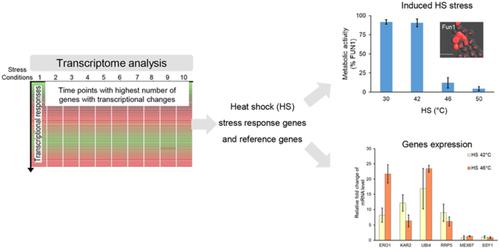Our official English website, www.x-mol.net, welcomes your
feedback! (Note: you will need to create a separate account there.)
Development of a method for heat shock stress assessment in yeast based on transcription of specific genes
Yeast ( IF 2.2 ) Pub Date : 2021-06-28 , DOI: 10.1002/yea.3658 Eugenio Meza 1 , Ana Joyce Muñoz-Arellano 1 , Magnus Johansson 1 , Xin Chen 1, 2 , Dina Petranovic 1
Yeast ( IF 2.2 ) Pub Date : 2021-06-28 , DOI: 10.1002/yea.3658 Eugenio Meza 1 , Ana Joyce Muñoz-Arellano 1 , Magnus Johansson 1 , Xin Chen 1, 2 , Dina Petranovic 1
Affiliation

|
All living cells, including yeast cells, are challenged by different types of stresses in their environments and must cope with challenges such as heat, chemical stress, or oxidative damage. By reversibly adjusting the physiology while maintaining structural and genetic integrity, cells can achieve a competitive advantage and adapt environmental fluctuations. The yeast Saccharomyces cerevisiae has been extensively used as a model for study of stress responses due to the strong conservation of many essential cellular processes between yeast and human cells. We focused here on developing a tool to detect and quantify early responses using specific transcriptional responses. We analyzed the published transcriptional data on S. cerevisiae DBY strain responses to 10 different stresses in different time points. The principal component analysis (PCA) and the Pearson analysis were used to assess the stress response genes that are highly expressed in each individual stress condition. Except for these stress response genes, we also identified the reference genes in each stress condition, which would not be induced under stress condition and show stable transcriptional expression over time. We then tested our candidates experimentally in the CEN.PK strain. After data analysis, we identified two stress response genes (UBI4 and RRP) and two reference genes (MEX67 and SSY1) under heat shock (HS) condition. These genes were further verified by real-time PCR at mild (42°C), severe (46°C), to lethal temperature (50°C), respectively.
中文翻译:

基于特定基因转录的酵母热休克应激评估方法的开发
所有活细胞,包括酵母细胞,都受到环境中不同类型压力的挑战,必须应对热、化学压力或氧化损伤等挑战。通过在保持结构和遗传完整性的同时可逆地调整生理机能,细胞可以获得竞争优势并适应环境波动。由于酵母和人类细胞之间许多基本细胞过程的强烈保守性,酵母酿酒酵母已被广泛用作研究应激反应的模型。我们在这里专注于开发一种使用特定转录反应检测和量化早期反应的工具。我们分析了已发表的酿酒酵母转录数据DBY 应变在不同时间点对 10 种不同应力的响应。主成分分析 (PCA) 和 Pearson 分析用于评估在每个个体应激条件下高度表达的应激反应基因。除了这些应激反应基因外,我们还鉴定了每种应激条件下的参考基因,这些基因在应激条件下不会被诱导,并且随着时间的推移表现出稳定的转录表达。然后,我们在 CEN.PK 菌株中对我们的候选者进行了实验测试。经过数据分析,我们确定了两个应激反应基因(UBI4和RRP)和两个参考基因(MEX67和SSY1) 在热冲击 (HS) 条件下。这些基因分别在轻度 (42°C)、重度 (46°C) 到致死温度 (50°C) 下通过实时 PCR 进一步验证。
更新日期:2021-06-28
中文翻译:

基于特定基因转录的酵母热休克应激评估方法的开发
所有活细胞,包括酵母细胞,都受到环境中不同类型压力的挑战,必须应对热、化学压力或氧化损伤等挑战。通过在保持结构和遗传完整性的同时可逆地调整生理机能,细胞可以获得竞争优势并适应环境波动。由于酵母和人类细胞之间许多基本细胞过程的强烈保守性,酵母酿酒酵母已被广泛用作研究应激反应的模型。我们在这里专注于开发一种使用特定转录反应检测和量化早期反应的工具。我们分析了已发表的酿酒酵母转录数据DBY 应变在不同时间点对 10 种不同应力的响应。主成分分析 (PCA) 和 Pearson 分析用于评估在每个个体应激条件下高度表达的应激反应基因。除了这些应激反应基因外,我们还鉴定了每种应激条件下的参考基因,这些基因在应激条件下不会被诱导,并且随着时间的推移表现出稳定的转录表达。然后,我们在 CEN.PK 菌株中对我们的候选者进行了实验测试。经过数据分析,我们确定了两个应激反应基因(UBI4和RRP)和两个参考基因(MEX67和SSY1) 在热冲击 (HS) 条件下。这些基因分别在轻度 (42°C)、重度 (46°C) 到致死温度 (50°C) 下通过实时 PCR 进一步验证。











































 京公网安备 11010802027423号
京公网安备 11010802027423号